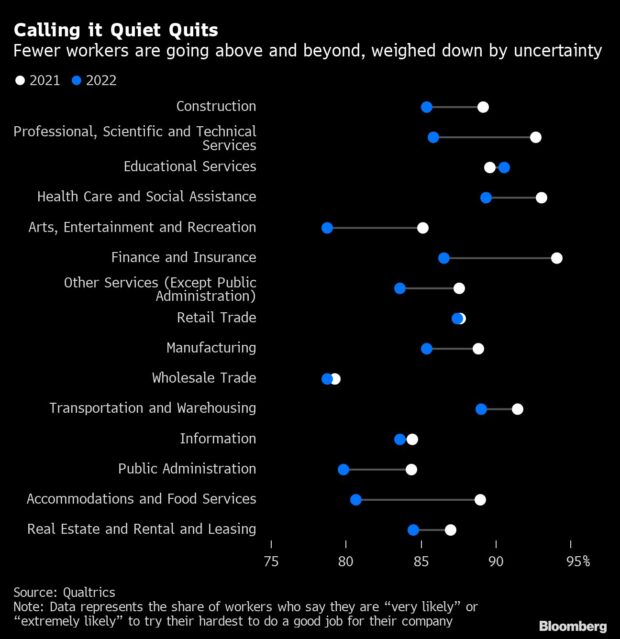The viral “quiet quitting” trend is taking hold in finance — once the industry with the most engaged workers, according to a new study.
The share of workers who said they’re “very likely” or “extremely likely” to try their hardest to do a good job for their company has waned overall since last year, according to a recent survey of more than 9,000 U.S. full-time or part-time employees by Qualtrics International Inc.
The finance and insurance sector had one of the biggest drops, with about 8 percent fewer employees reporting willingness to give it their all on the job, matched only by accommodations and food services. That’s a big change from 2021, when the finance and insurance industry claimed the highest share of engaged employees at 94 percent.
In 2022, education services claimed that title, the only sector with a net gain in workers who said they’re very or extremely likely to try their best. After a 1 percent bump, it now boasts the highest share of highly committed employees at 91 percent.
Ben Granger, Qualtrics’s chief workplace psychologist, said that the data likely reflects a confluence of factors, from the ongoing pandemic and inflation to geopolitical crises.
“When you step back to consider this volatile external environment that we are in, it’s not surprising that many people are evaluating the role of work in their lives differently,” he said in an email. “And for some, that means taking their foot off the gas pedal at work.”
But quiet quitting isn’t rampant yet. Across the 15 industries surveyed, only about 10-20 percent of employees of each said they weren’t giving it their all, data from Qualtrics, an experience management and software company, show. That’s much lower than Gallup’s estimate from its recent employee engagement survey, which found that a full 50 percent of the U.S. workforce could be considered quiet quitters, defined as “people who do the minimum required and are psychologically detached from their job.”
The discrepancy can be attributed to the ambiguity of the term itself — different definitions suggest different measurement methods, and there’s a vocal cohort who thinks quiet quitting isn’t a phenomenon at all.
“There are many open questions about how we can actually measure or detect quiet quitting,” Granger said. “Its quiet nature makes it naturally harder to measure, and this is precisely why organizational leaders are so concerned about it.”
Top photograph: A worker, top left, looks out from an illuminated office window by his desk in London, UK, on Oct. 14, 2013. Photo credit: Simon Dawson/Bloomberg






















 NOAA Announces Latest AI-Driven Global Weather Models
NOAA Announces Latest AI-Driven Global Weather Models  How Insurers Can Avoid Post-Merger Technology Failure
How Insurers Can Avoid Post-Merger Technology Failure  Northern California Flooding This Weekend Caused by Heavy Rain, High Tides
Northern California Flooding This Weekend Caused by Heavy Rain, High Tides  Good Times for U.S. P/C Insurers May Not Last; Auto Challenges Ahead
Good Times for U.S. P/C Insurers May Not Last; Auto Challenges Ahead 






